#medieval meals
Text
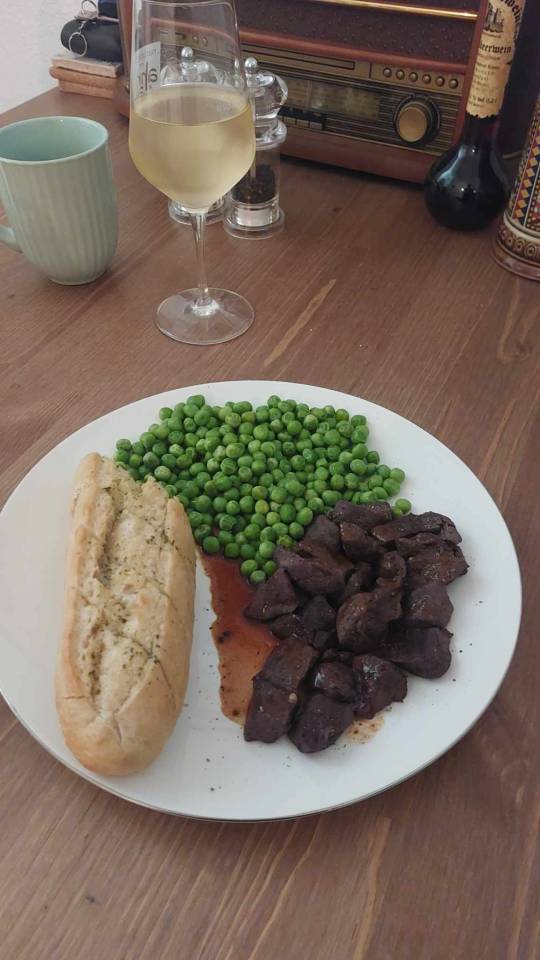
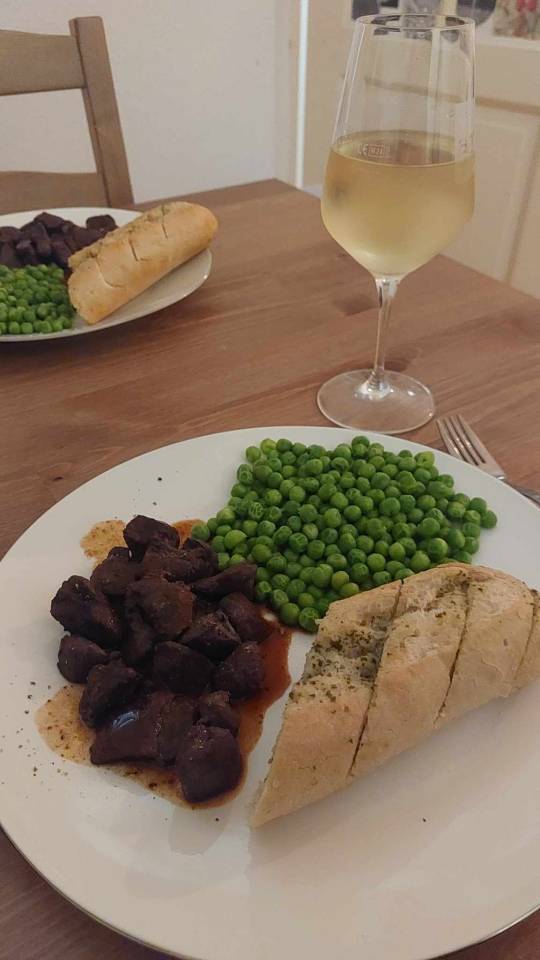
TEMPLAR BOAR WITH CAMELINE SAUCE (14th c.)
This past Thursday, the Corpus Christi public holiday in my part of Germany, known here as Fronleichnam, gave me a little extra time to make another Tasting History dish: Templar Boar with Cameline Sauce. The diet, eating habits, and table manners of the Templars were governed by strict rules, including only eating meat three times a week (two meat meals on Sundays). This dish was one of those they would have eaten for one of their meat meals during the 14th century. The spices present in the sauce would have been accessible to them during the crusades, but Cameline Sauce did become a popular dish in much of medieval Europe eventually. This dish is based on two 14th century primary sources: Le Viandier de Taillevent by Guillaume Tirel and Le Ménagier de Paris, a treatise written by an older man (as yet unnamed) to teach his 15-year-old bride how to run his household and please him, in every way (...yikes). The sauce, Cameline, is named as such due to the rich brown colour, which looks like the wool of a camel, also known as cameline. I chose to make this recipe next because I haven't made boar before, and the rich, silky, brown colour of the sauce made it look really tasty. See Max’s video on how to make it here or see the ingredients and process at the end of this post, sourced from his website.
My experience making it:
I made a couple changes to the modern recipe below. I used boar goulash pieces instead of tenderloin, because it was the only form of boar I could find at my grocery store. The white wine I used (and drank with dinner) was a dry Riesling from the Mosel Valley in Germany. The red wine was a Bordeaux Merlot. I used saffron powder instead of threads, and I did opt to add the optional tablespoon of red wine vinegar. the white bread I used was a classic French baguette.
I also made a couple changes to the method. Because I used French baguette, which has quite small slices, I hollowed out about half the baguette (since baguettes are mostly crust). I also simmered the sauce for much longer than Max says to, because it wasn't quite the thickness I was looking for. Otherwise, I followed Max's recipe exactly, probably to the detriment of my boar. Because I had used goulash pieces instead of tenderloin, I probably should have adjusted how I cooked the boar to accommodate these smaller pieces. Unfortunately, I didn't, and as a result, I was left with very chewy, dry boar. Basically, the sauce was the saving grace of the boar! I served the boar and Cameline sauce with some green peas, garlic bread, and a glass of the dry Riesling wine.
My experience tasting it:
I already knew I had ruined the texture of the boar, but I hoped that the sauce would help. I warned my husband. Luckily, the Cameline sauce did a lot of heavy-lifting to bring some moisture back to the board. The sauce turned out wonderfully - a beautiful, silky brown. Flavour-wise, it reminded me of a jus, but more heavily-spiced. I was worried the Cameline sauce would end up tasting sweet due to the brown sugar and several spices that are more often used in baking, but in fact, the spices were well balanced by the taste of the wine and vinegar. The sauce also went really nicely with the peas, and I imagine would also have tasted good with potatoes or other red meats. My husband and I dipped the garlic bread in it as well, which was really tasty. It went alright with the dry boar, but I would like to use the sauce with another, more tenderly-cooked meat. We had leftover Cameline sauce, so we will probably try that again tonight. If you end up making it, if you liked it, or if you changed anything from the original recipe, do let me know!
Links to harder-to-find ingredients:
Saffron
Templar Boar with Cameline Sauce original recipes (14th c.)
Sourced from Le Viandier de Taillevent by Guillaume Tirel and Le Ménagier de Paris respectively.
“Sanglier:
Fresh Wild Boar Venison. Cooked in wine and water and boiled again; eaten with Cameline Sauce.”
— Le Viandier de Taillevent, 14th century
“Cameline.
Note that in Tournai, to make cameline they grind ginger, cinnamon, saffron, and half a nutmeg, moistened with wine then taken out of the mortar. Then grind in a mortar untoasted white breadcrumbs that have been soaked in cold water, moisten with wine and strain. Then boil everything and finish with brown sugar, and that makes winter cameline. In the summer, they do the same but it is not boiled at all. ”
— Le Ménagier de Paris, 14th century
Modern Recipe
Based on Le Viandier de Taillevent by Guillaume Tirel, Le Ménagier de Paris, and Max Miller’s version in his Tasting History video.
Ingredients:
Boar tenderloin
Olive oil for searing
Equal parts wine and water for boiling
1 thick slice of white artisanal bread without crust
1 ¼ cups white wine
¼ cup red wine
1 tsp ginger
2 tsp cinnamon
½ tsp nutmeg
Pinch of saffron threads
2 tbsp brown sugar
Pinch of salt
1 tbsp red wine vinegar (optional)
Method:
De-crust the bread and break it into small pieces. Soak the bread in water for a few hours, then pour in the red wine for the sauce.
Heat olive oil in a pot then sear the boar on all sides.
Remove it from the pot and boil equal parts wine and water, then add the boar back in and boil, covered, for 10-15 minutes or until fully cooked. Then let it rest.
To make the sauce, mix the spices and white wine. Strain the bread/wine mixture from earlier into a saucepan, then press the bread through the strainer.
Add the spiced wine mixture and bring to a simmer. Let simmer for 15 minutes, or until half reduced, then add the sugar and salt, and if you want, a tablespoon of red wine vinegar. Simmer until thickened.
Slice the boar and pour the sauce over it. Optionally, serve with roasted chestnuts and wine.
#14th century#max miller#tasting history#cooking#tasting history with max miller#keepers#medieval meals#boar#french recipes#europe#Templar#crusades#Cameline Sauce#Sauces#meat#Le Viandier de Taillevent#Le Menagier de Paris#Guillaume Tirel#Europe#France
3 notes
·
View notes
Text
what if you gave a medieval person a pepsi? the sugar would send her into shock but she's also been drinking mead since she was like 9 so??? her tolerance for alcohol? amazing. Sugar? uh oh
#tbd#im watching these 'what medieval people eat' and its very fun#apparently everyone always had mead with their meals!
13 notes
·
View notes
Text







My Arisen, Nimh 🍠
#clyde.txt#nimh#dragon's dogma 2#dd2#rest in peace to lir in the last image i used his K.O. rift fog as a background....#some shots of my arisen for once.... hehe#why sweet potato emoji?? who knows.... medieval meal
22 notes
·
View notes
Text
today we're making bread AND carrot cake
they'll bake separately, but if I need to have my oven on, I might as well take full advantage of it, you know?
#jau rants#bread was a request from partner for dinner#medieval peasants had it right so bread and cheese is a regular meal choice now
16 notes
·
View notes
Text
Dungeon meshi has wonderful and thought out world building but the inherent creator bias still shows through sometimes in small funny ways
#dungeon meshi#ep 1#why are they eating with chopsticks when the island is mostly western in architecture/culture etc#hahaha#i always think its so funny even in like medieval isekais/webtoons#when everyone has european names#castles#dresses etc#but their school system is japanese or their meals etc#like the small stuff the author thinks is normal#calling the duke 'hyung' when there is absolutely no way that would happened at that time#its a bit endearing#i read a brothers grimm/fairy tale inspired manga#and the protag is a grimm brother who befriends hans christian andersen and subsequently calls him “an-chan”#western media has that a lot too#people eating with forks when they would use chopsticks#having meals with beef in them when its a terrain where cows wouldnt live and chicken or goat or fish would make more sense#eastern media aallllwaaysss including an age based honorifics system#western media often modeling religion along the abrahamic faiths#etc
26 notes
·
View notes
Text

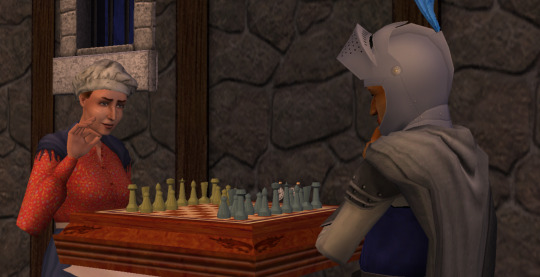
-- A game of chess, Arista? I didn't know you played.
--The creatures are put to bed. They're growing mighty fast.

-- Good. Soon enough I can train them. Once they're of age, I can present them to the queen as new knights of the realm.
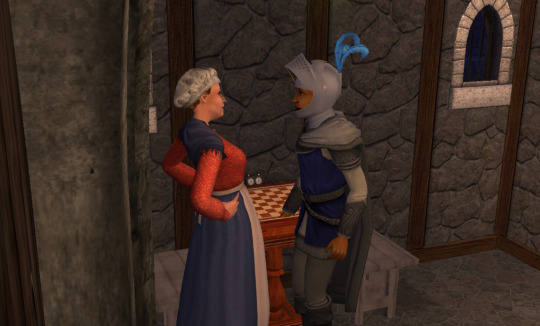
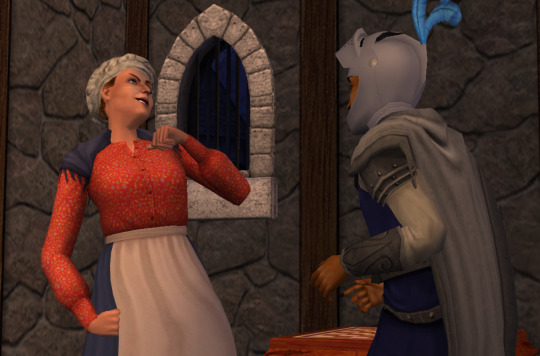
--Arista, I appreciate you looking after them. It's no small task.
--Aye. But I've got the experience.
--If you don't mind me asking...you've raised children before? Your own?
-- You think I've got children? Where dya suppose I'd be hidin' them? No. My work as a scullery maid in days past. Weaned many a babe in my day.
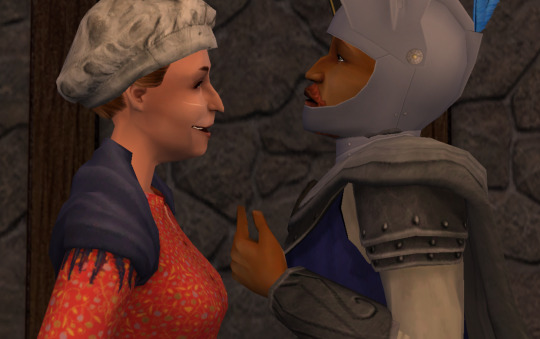
-- Your confidence is staggering. You remind me of a woman I once knew.
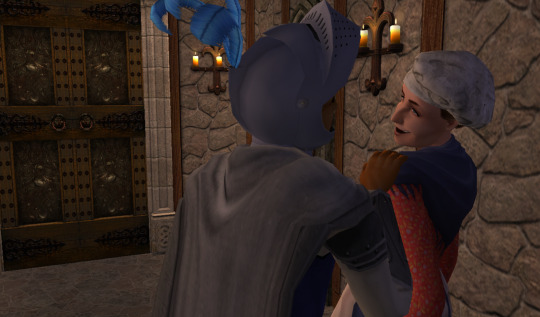
-- Can't be. I'm one of a kind, sherriff.

#BLEGH a la most important meal of the day serving it up gary's way#ts2#the sims 2#the sims#sims stories#ts2 gameplay#sims 2#sims 2 medieval#sims warwickshire challenge
12 notes
·
View notes
Text

#gwyn ap nudd#medieval literature#medieval welsh#medieval irish#welsh mythology#celtic studies#something something a hearty meal#i can't believe i'm awake thinking of heart puns when aorta be sleeping 🥁#thank you i'll be here all week#(good night for real though and sorry for spamming you all tonight 😘)
10 notes
·
View notes
Note
I zoomed in on the dinner table in episode 8 and the vegetarian items are mostly the desserts there were like 3 pies 🥧
There was bread over by where lucerys was sitting
Alicent and Otto had some weird caviar looking thing?
There’s ham and what looks like a lobster ?
Turkey maybe?
Lots of green beans
A fruit salad bowl
Grapes
Peas
Pastries
Aegon has a whole ass chicken on his plate to himself I love that for him
Helaena seems to be the only one with no food on her plate :(
Lots of wine
Honestly, Aegon having a whole chicken to himself is a very common thing for people of his status and I love that for him and absolutely adore this little detail
#this ask makes me think about medieval customs of the meal starting from the highest on the hierarchy#really makes me wonder how all of that menu would go through viserys first and then everyone else and in what order#asks??? in my establishment???
14 notes
·
View notes
Text
me, eating a pile of nuts, cheese, and apple: mmmm tasty
the medieval peasant in my head watching me eat: thou knowst what would MAKETH this meal? dried fruits.
me, getting out the raisins: god damn, etheldred, you are SO right
the medieval peasant in my head: yet thou art still not heeding mine words regarding the blasphemy
#i never feel closer to medieval peasants than when i eat a meal of apple and cheese#(<- revised gluten free version (used to be cheese and bread))#the nuts are a recent addition but still very medieval feeling#and dried fruits???? oh babey now that's not just an after dinner snack that's a whole entire meal
3 notes
·
View notes
Text


ARMOURED TURNIPS (15th c.)
I finally found some turnips at the grocery store after many weeks scouring farmer's markets and grocers in my area, so I was able to make this Tasting History recipe, which has been on my to-make list for several weeks now: Armoured Turnips, a 15th century version of potatoes au gratin. The recipe comes from De Honesta Voluptate et Valetudine by Bartolomeo Sacchi, also known as Platina, and it was published in Renaissance Italy in 1499. A contemporary of Leonardo da Vinci, this cookbook was actually one he owned! I chose to make this recipe because you can't often go wrong with a dish starring cheese and butter, and I thought it would be fascinating to try a dish that Leonardo da Vinci may have made himself. See Max’s video on how to make Armoured Turnips here or see the ingredients and process at the end of this post, sourced from his website.
My experience making it:
This recipe felt a lot less specific than some of the other historical ones I've made, especially in terms of ingredients. While Max used two probably very accurate cheeses to what Leonardo da Vinci would have had, I lazily decided to use two cheeses I knew would melt well and have a little taste, but not enough to overpower the dish: white cheddar and gouda. For my Poudre Douce, I used some spices that Max recommends, but I threw in a few of my own choosing. I used ginger, brown sugar, nutmeg, black pepper, clove, and cardamom. For the butter, I went a bit fancy and used some sea salt butter from Brittany. The turnips I used were three large, white ones. I didn't include the parts of them that seemed a little too fibrous.
I first peeled and boiled the turnips, then let them cool and chopped them into slices (not quite knife-blade thin, more like the size Max sliced them). I put together my spice mix, partially based on Max's recommendation, but adding in a few spices I enjoy to make it my own Poudre Douce. Individually, I'm not a big fan of each spice, but together they did smell very lovely. Layering the turnips, spices, cheese, and melted butter in the casserole dish was actually super fun, and quite satisfying. Despite the fact I would have needed more layers, I did wish I had listened to the instructions and cut the turnips thinner. I tossed the Armoured Turnips in the oven, and took it out once the cheese was bubbling and sizzling. I served it with some serrano ham and creamed cauliflower and broccoli. The butter pooled a little on top, and serving it was difficult, but impressive; one strand of cheese stretched about a metre!
My experience tasting it:
My first bite, though it contained turnip and spice, was mostly a mouthful of melted cheese. No complaints here! The cheese, like Max mentions, is really the star of this dish, and I can imagine that the taste of the dish would change drastically if you used different cheeses. Luckily, I think the white cheddar and gouda I chose suited the turnips and the spices nicely. I will admit, the spices really take a back seat in this dish, adding just a hint of flavour. The tunips themselves were cooked nicely and did suit their cheesy armour, but in future, I would slice them thinner in order to make the dish a little more cohesive (the turnips and cheese did separate from each other quite easily). While my husband and I both enjoyed Armoured Turnips, it is definitely a dish you only want to have a little of due to the amount of cheese and butter in it - not only for health reasons, but for the sheer decadence of flavour. In future, I would make this dish only once in a while, and even then, I might consider using potatoes instead of turnips, if only to absorb some of the butter so it doesn't look so absolutely artery-clogging. Still, I would consider this dish a keeper, but only for special occasions! If you end up making this dish, if you liked it, or if you changed anything from the original recipe, do let me know!
Armoured Turnips original recipe (1499)
Sourced from De Honesta Voluptate et Valetudine by Bartolomeo Sacchi, AKA Platina, 1499.
Cut up boiled or ash roasted turnips; do the same with rich cheese, not too ripe, but make the cheese pieces thinner than the turnip. In a pan greased with butter or other fat, make a layer of cheese first, then one of turnips; repeat, pouring in spice and butter from time to time. It should be quickly cooked and quickly eaten.
Modern Recipe
Based on De honesta voluptate et validudine by Bartolomeo Sacchi, AKA Platina (1499), and Max Miller’s version in his Tasting History video.
Ingredients:
1 1/2 lbs (700 g) turnips, washed and peeled
3/4 lb (340 g) cheese, flavorful but not too strong, Max used Fontina and Taleggio
1 stick (110 g) salted butter, melted
Poudre douce*
*Poudre douce, or sweet powder, is a spice mixture that changed slightly from person to person. It typically was made of spices like clove, cinnamon, ginger, nutmeg, and sometimes sugar.
Method:
Preheat the oven to 400°F (205°C).
Roast or boil the turnips. I cut mine in half because they were rather large, and boiled them for 15 minutes. Whether you roast or boil the turnips, don’t overcook them because they’ll get cooked more in a little bit. Let the turnips cool.
Slice the turnips “as thin as the spine of a knife”, and slice the cheese a bit thinner than that, as best you can.
Coat the bottom and sides of a small casserole dish with a little of the melted butter.
Place a layer of sliced cheese on the bottom of the dish, cover that with a layer of sliced turnip, then sprinkle a large pinch of the spice mixture over it and drizzle some of the melted butter over that. Repeat the layers of cheese, turnips, spice, then butter until the dish is full, and finish it off with a layer of cheese on top.
Bake for 12 to 15 minutes, or until the cheese is fully melted and starting to bubble around the sides.
Let it cool for 5 minutes, then serve it forth.
#De honesta voluptate et valetudine#platina#medieval meals#italy#europe#Renaissance#max miller#tasting history#tasting history with max miller#cooking#historical cooking#keepers#15th century#turnips#cheese#casserole#vegetarian recipes#bartolomeo sacchi#leonardo da vinci
2 notes
·
View notes
Text
i'm a simple girl. i load up pentiment, and i get prior ferenc killed
#pentiment#pentiment spoilers#look in my defense he was usually the only one i got any info on#i was too busy planning meals in the forest and talking about medieval german racism
14 notes
·
View notes
Text

I had thoughts on fun au’s and so medieval knights came into play. Then I thought I haven’t drawn young Devious so tadaaa and I gave him a new recruit too and gave him King status in this au.
Anyway enjoy my doodle and thought dumps
#I have thoughts but they’re always delulu thoughts#me: I am an adult! also me: makes fictional men have funny little lives#I need happiness and happy meals are expensive (so is therapy)#anyway young Devious is both cute and spicy#and Vil is just cute ;v;#I can’t design crowns or armour#oc art#original character#buggee art#medieval#knights#oc#Devious
5 notes
·
View notes
Text
Is there anything more heavenly than warm bread and jam with cheeses and butter?
#personal#please help me the autism has daned this the new comfort meal#my dear lord the carbs and lactose in my combos#fuck#this aint good for the ibs#or the lactose intolerance#but its the only food that makes ke not wanna die currently#safe foods#feel like a medieval peasant
8 notes
·
View notes
Text
the ideal dynamic for rubber bands and scissors is just fairy godmother and prince charming
8 notes
·
View notes
Text
youtube
2 notes
·
View notes
Text
NEW IZZZYZZZ VID!!!!!!
#unfortunately i just ate so i cannot perform the medieval meal+entertainment combo...#but we will be watching regardless !!!!!
15 notes
·
View notes